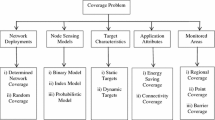Abstract
In this paper, we study the delay-constrained information coverage problem in mobile sensor networks. Motivated by real application needs, our formulation takes advantage of the sensor mobility for sensing information collection, which takes place when a sensor moves into the proximity (single hop) of stationary sink nodes. To the best of our knowledge, we present the first formulation for the delay-constrained information coverage problem, which targets at optimal sink nodes placement with the objective of maximizing sensing information collection within a constrained time. We prove that this problem is NP-hard even under finite search space approximation and we develop theoretical analysis to derive its upper and lower performance bounds. We then develop approximation techniques and use simulations to verify their effectiveness.











Similar content being viewed by others
Abbreviations
- A :
-
A vast 2-D geographic area
- M :
-
The number of mobile sensors
- ℵ:
-
The set of sink nodes
- N :
-
The number of sink nodes, and N ≥ 1, and ℵ
- S h :
-
The coverage region of stationary sink node h, and S h ∈ A, 1 ≤ h ≤ N
- R :
-
The coverage range of a sink node
- T :
-
A time interval for the information coverage
- D(A, t0):
-
The sensor position distribution across the area A at the initial time instant t 0
- θ:
-
The moving direction of mobile sensors, [0, 2 π)
- v :
-
The speed of mobile sensors
- r v :
-
The travel distance of mobile sensors at each \(\bigtriangleup t\). It depends on the mobile platform of sensors and r v ≪ A
- \(\bigtriangleup t\) :
-
The discrete time interval in which each sensor movement occurs
- P(r, θ, t):
-
The probability of a mobile sensor lays at distance r and angle θ from its initial position at time t
- d :
-
The radius of circular probability distribution for a single mobile sensor at the initial time instant t 0 (The radius of disk distribution)
References
Ad Hoc UAV Ground Network (AUGNet): University of Colorado. http://www.augnet.colorado.edu/
ZebraNet: Princeton University. http://www.princeton.edu/~mrm/zebranet.html
Hull, B., Bychkovsky, V., Chen, K., Goraczko, M., Miu, A., Shih, E., Zhang, Y., Balakrishnan, H., & Madden, S. (2006). CarTel: A distributed mobile sensor computing system. In Proceedings of ACM conference on embedded networked sensor systems (SENSYS), November, 2006.
Vahdat, A., & Becker, D. (2000). Epidemic routing for partially connected ad hoc networks, Technical Report CS-2000-06, Department of Computer Science, Duke University.
Small, T., & Haas, Z. J. (2003). The shared wireless infostation model—a new ad hoc networking paradigm (or where is a whale, there is a way). In Proceedings of ACM international Symposium on mobile ad hoc networking and computing (MOBIHOC), June, 2003.
Lindgren, A., Doria, A., & Schelen, O. (2003). Probabilistic routing in intermittently connected networks. ACM SIGMOBILE Mobile Computing and Communications Review, 7(3).
Wang, Y., & Wu, H. (2006). DFT-MSN: The delay/fault-tolerant mobile sensor network for pervasive information gathering. In Proceedings of IEEE conference on computer communications (INFOCOM), April, 2006.
Lima, L., & Barros, J. (2007). Random walks on sensor networks. In Proceedings of WiOpt, April, 2007.
Shah, R., Roy, S., Jain, S., & Brunette, W. (2003). Data mules: Modeling a three-tier architecture for sparse sensor networks. In Proceedings of the IEEE workshop on SNPA, May, 2003.
Shi, Y., & Hou, Y.T. (2007). Approximation algorithm for base station placement in wireless sensor networks. In Proceedings of IEEE conference on sensor, mesh and ad hoc communications and networks (SECON), June, 2007.
Shi, Y., & Hou, Y. T. (2008). Theoretical results on base station movement problem for sensor network. In Proceedings of IEEE conference on computer communications (INFOCOM), April, 2008.
Pásztor, B., Musolesi, M., & Mascolo, C. (2007). Opportunistic mobile sensor data collection with SCAR. In Proceedings of IEEE conference on mobile adhoc and sensor systems (MASS), October, 2007.
Crossbow, I. (2005). Avoiding RF interference between WiFi and Zigbee. Technical Report, Crossbow Technology Inc.
Garey M. R., & Johnson, D. S. (1979). Computers and intractability: A guide to the theory of NP-completeness. New York: W. H. Freeman and Company.
Ostrovsky, R., & Rabani, Y.(2000). Polynomial time approximation schemes for geometric k-clustering. In Proceedings of IEEE Symposium on foundations of computer science, November, 2000.
Camp, T., Boleng, J., & Davies, V. (2002). A survey of mobility models for ad hoc network research. In Wireless communication and mobile computing (WCMC): Special issue on mobile ad hoc networking research, trends and applications, 2(5), 483–502, September, 2002.
Liu, B., Brass, P., Dousse, O., Nain, P., & Towsley, D. (2005). Mobility improves coverage of sensor networks. In Proceedings of ACM international Symposium on mobile ad hoc networking and computing (MOBIHOC), May, 2005.
Stadje, W. (1987). The exact probability distribution of a two-dimensional random walk. Journal of Statistical Physics, Springer.
Pham, D. T., & Karaboga, D. (2000). Intelligent optimisation techniques: Enetic algorithm, tabu search, simulated annealing, and neural network. Berlin: Springer.
Beisiegel, B., Kallrath, J., Kochetov, Y., & Rudnev, A. (2005). Simulated annealing based algorithm for the 2D bin packing problem with impurities. In Proceedings of operations research, Springer.
Keung, G.Y., Li, B., & Zhang, Q. Message delivery capacity in delay-constrained mobile sensor networks: Bounds and realization (to be submitted).
Acknowledgment
The research was support in part by grants from RGC under the contracts 615608, and 616207, by a grant from NSFC/RGC under the contract N_HKUST603/07.
Author information
Authors and Affiliations
Corresponding author
Rights and permissions
About this article
Cite this article
Keung, G.Y., Zhang, Q. & Li, B. The delay-constrained information coverage problem in mobile sensor networks: single hop case. Wireless Netw 16, 1961–1973 (2010). https://doi.org/10.1007/s11276-010-0238-2
Published:
Issue Date:
DOI: https://doi.org/10.1007/s11276-010-0238-2




